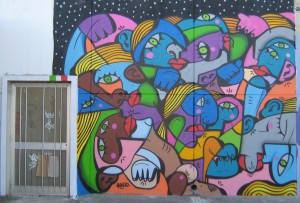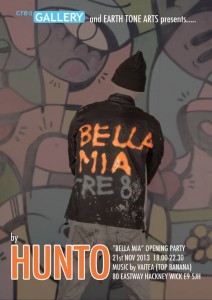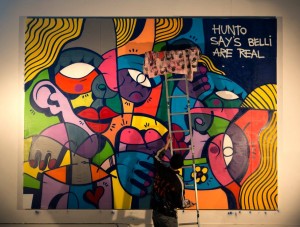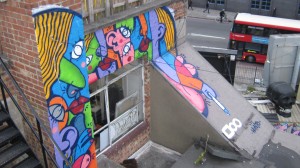About a week ago, I started to investigate to what extent graffiti and cartoons carrying subtle political meanings can shape public opinion. To refresh the reader’s memory, I interviewed Simon Key, a British cartoonist who shed some light on the issue. Now it’s time to listen to the different thoughts of street artist Hunto, who was born and raised in Italy and currently lives in East London.
Q. Are graffiti artists using their art as a way to voice their political feelings?
A. Nowadays everyone seems to believe that street art always expresses political concerns. It can be used for that purpose, of course. However, the issue is not that simple: one should better look at the origin of street art if wants to really grasp its actual meaning. Otherwise, it is easy to draw the wrong conclusion. Having said that, art is purely subjective: as such, it means something different from each artist. For example, I don’t consider myself as a conventional graffiti artist, if you like: I have never used street art to voice my political feelings, and I probably never will. Instead, my work revolves around my own ideas, symbols, and sensibility, and I try to create a connection between them and my name. Surely, many street artists have a very divergent point of view: yet, like I said, art is subjective.
Q. Do you believe street art and cartoons could be considered equally powerful political weapons?
A. I wouldn’t narrow the issue down like that, because not only graffiti and cartoons, but also any form of art can be considered a political weapon. Art as a whole is a strong force, let me put it in this way.
Q. In a rare recent interview, Banksy described street art as complicated because ‘it feels like as soon as you profit from an image you’ve put on the street, it magically transforms that piece into advertising’. How far do you agree with this statement?
A. I’ve never really thought about that, but I think I can agree with Banksy.
Q. According to the cartoonist Key, the art of graffiti can be either intrusive or it can give a sense of positive urban life. How would you comment on that? And what about Shoreditch street art?
A. This is an interesting point … Art is open to a plurality of reading, and it remains resistant to any rigid, let alone right interpretation. In fact, it doesn’t even exist general agreement among street artists! Personally, my works are fuelled by my inner creative impulses: I just allow myself to paint. Regarding Shoreditch street art, there is not such a thing as a distinction between north and south, east and west. Again, art is purely art, and street art is street art, no matter where you are.

A. To conclude, can you tell us a bit more about your solo show coming up?
Q. My new solo show, Bella Mia, collects a body of works inspired by female forms and features. Bella Mia is a typical Italian expression which means endearment, and it could be translated as “My beauty”. It refers to the feeling of instantaneous curiosity arousing from anything that you wish to experience, touch, and explore, without knowing the reason behind such strong desire… It is all about my vision and creation of different women, attitudes, bodies, and gestures. Put simply, it’s my tribute to female beauty in all its nuances.








